The Amazing Little Cloud Cable
The S2CT Cloud Cable is our entry level Asset Monitor product concept. Its basic intent is to connect disjoint points together, wirelessly, using HME Sub GHz(1) communications. The Cloud Cable can be generally thought of as providing the functionality of a physical cable connecting a target point, the point where the Cloud Cable is installed, to one or more other points. With that said, the Cloud Cable is a little more capable than a wire as it is microcontroller based to fully execute S2CT device-to-device authentication, data encryption and decryption, advanced power management, and can be programmed to execute a single or limited number of application tasks. Given the current state of even low-end microprocessors, powerful, with abundant memory and support for on-board storage, these tasks can be quite sophisticated. Cloud Cables with integrated sensors can be configured and programmed to operate as Proportional Integral Derivative (PID)(2) System Controllers. Such a PID Cloud Cable could manage the operational parameters of refrigerated assets, reefer trucks and containers and cold storage units using classical, sophisticated, PID equations:

This requires the Cloud Cable's microcontroller to continuously evaluate the cold unit's environmental data, from its sensors, and to make continuous adjustments to the unit's operating parameters driven by the PID equations. Cloud Cables can be "Smart".
More typically, Cloud Cables rely on other devices they connect to and the cloud for more sophisticated multitasking functionality and data analytics. S2CT's White Paper entitled "IBM Cloud, Blockchain, S2CT's Global Asset Management Architecture and Ubiquitous Wi-Fi Render GPS and Digital Cellular Networks Communications Obsolete in the Global Supply Chain" describes a comprehensive deployment and use model of a variety of Cloud Cable configurations.
All S2CT Cloud Cables are programmable microcontroller based devices, have plug-in Battery Power Systems, integrated Sub GHz subsystems with an embedded Sub GHz antenna, integrated Magnetic Inductance (Mag-I(3)) with an embedded Near Field Mag-I antenna, a standard set of six programmable Input / Output pins, 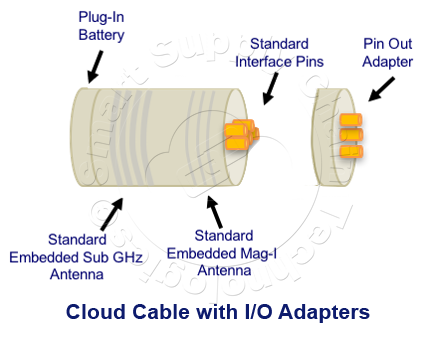 a minimum of 8Kbytes of non-volatile RAM for Data Logger (64 pings). The standard Battery Power System can house up to 3 AA batteries with "Smart" Advanced Power Management for extended life. Standard I/O adapters are available for USB, Serial, GPIO and UART data plugs. Entry level Simple Cloud Cables are intended to communicate through Sub GHz to Wi-Fi enabled Cloud Cables or directly to Sub GHz enabled Wi-Fi Access Points. Simple Cloud Cables will sell for around $25 USD and Wi-Fi enabled Cloud Cables for around $30 USD. A single standard 802.11b/g/n Wi-Fi Access Point can provide network communications to hundreds of Cloud Cables in its field of coverage.
a minimum of 8Kbytes of non-volatile RAM for Data Logger (64 pings). The standard Battery Power System can house up to 3 AA batteries with "Smart" Advanced Power Management for extended life. Standard I/O adapters are available for USB, Serial, GPIO and UART data plugs. Entry level Simple Cloud Cables are intended to communicate through Sub GHz to Wi-Fi enabled Cloud Cables or directly to Sub GHz enabled Wi-Fi Access Points. Simple Cloud Cables will sell for around $25 USD and Wi-Fi enabled Cloud Cables for around $30 USD. A single standard 802.11b/g/n Wi-Fi Access Point can provide network communications to hundreds of Cloud Cables in its field of coverage.
S2CT Cloud Cables will be available in a variety of configurations and can easily be customized for a specific task. Cloud Cables can be permanently or temporarily installed on or in an asset, containers, truck trailers, truck cabs, chassis, railway cars, vessels, gensets, spreaders, cranes, forklifts, pallets, warehouses, shipping depots, factory floors, truck cabs, cold storage units, dry storage units, etc., the list is only limited by one's imagination.
Cloud Cables can be installed in an asset by themselves or as "Masters" in local-area networks of Cloud Cable. A Cloud Cable local-area network is typically comprised of a master unit and a number of disjoint Cloud Cable slaves. Slave Cloud Cables are placed in the same general area as the master but in locations appropriate for their specific tasks. A Cloud Cable master might be collecting temperature data from its own integrated sensor and from slave Cloud Cables installed in the four corners of a trailer's cargo area. The Cloud Cable master aggregates all of this temperature data and communicates it to an Asset Management System where a profile of the temperature gradient across the cargo area can be developed and analyzed.
Cloud Cables can be permanently installed on a specific asset or moved from one asset to another. In either case, it is important to know which asset the Cloud Cable's data is associated with. To this end, an inexpensive Mag-I Tag, with a unique embedded digital ID, can be permanently attached in a convenient location on an asset. When a Cloud Cable is installed or moved to a new asset, 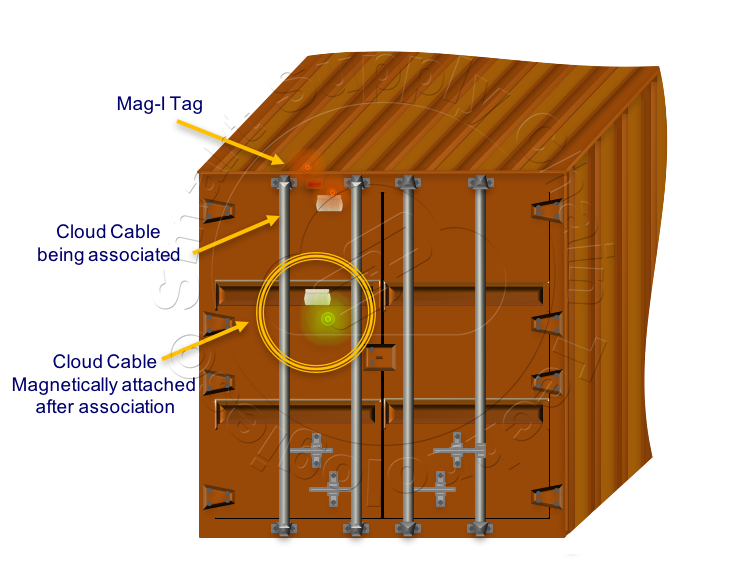 the installer simply touches the Cloud Cable to the Mag-I Tag and waits a second or so for the Cloud Cable's "Association" LED to blink. When the Cloud Cable is touched to a Mag-I Tag, the Mag-I Tag ID is transferred and stored in the Cloud Cable. That Mag-I ID is then inserted in all data packets that the Cloud Cable communicates to the asset owner's Asset Management System. The Asset Management System can either use the Mag-I ID to distinguish different assets or cross reference them to other asset IDs already used within the asset owner's workflow, a container number for example.
the installer simply touches the Cloud Cable to the Mag-I Tag and waits a second or so for the Cloud Cable's "Association" LED to blink. When the Cloud Cable is touched to a Mag-I Tag, the Mag-I Tag ID is transferred and stored in the Cloud Cable. That Mag-I ID is then inserted in all data packets that the Cloud Cable communicates to the asset owner's Asset Management System. The Asset Management System can either use the Mag-I ID to distinguish different assets or cross reference them to other asset IDs already used within the asset owner's workflow, a container number for example.
Cloud Cables must also be flexible enough to be deployed in a variety of asset applications, from simple monitoring and tracking to interfacing to sophisticated asset control systems, a cold storage unit's refrigeration controller for example. Simple monitoring and tracking only requires that the Cloud Cable and its "paired" wireless sensors, if there are any, be appropriately installed on or in the asset. Appropriate means in the best location on or in an asset to execute its programmed task and in some cases, it means out of harm's way, blended into the asset's superstructure such that its presence is not obvious. To these ends, Cloud Cables are completely compatible with S2CT's component modularity and universal enclosure concepts(4).
In sophisticated deployments, where the Cloud Cable is a conduit between the cloud and another electronic device, the Cloud Cable must be flexible enough to be connected to any target interface or connector. Cloud Cables meet this challenge with extensive and flexible I/O capability. 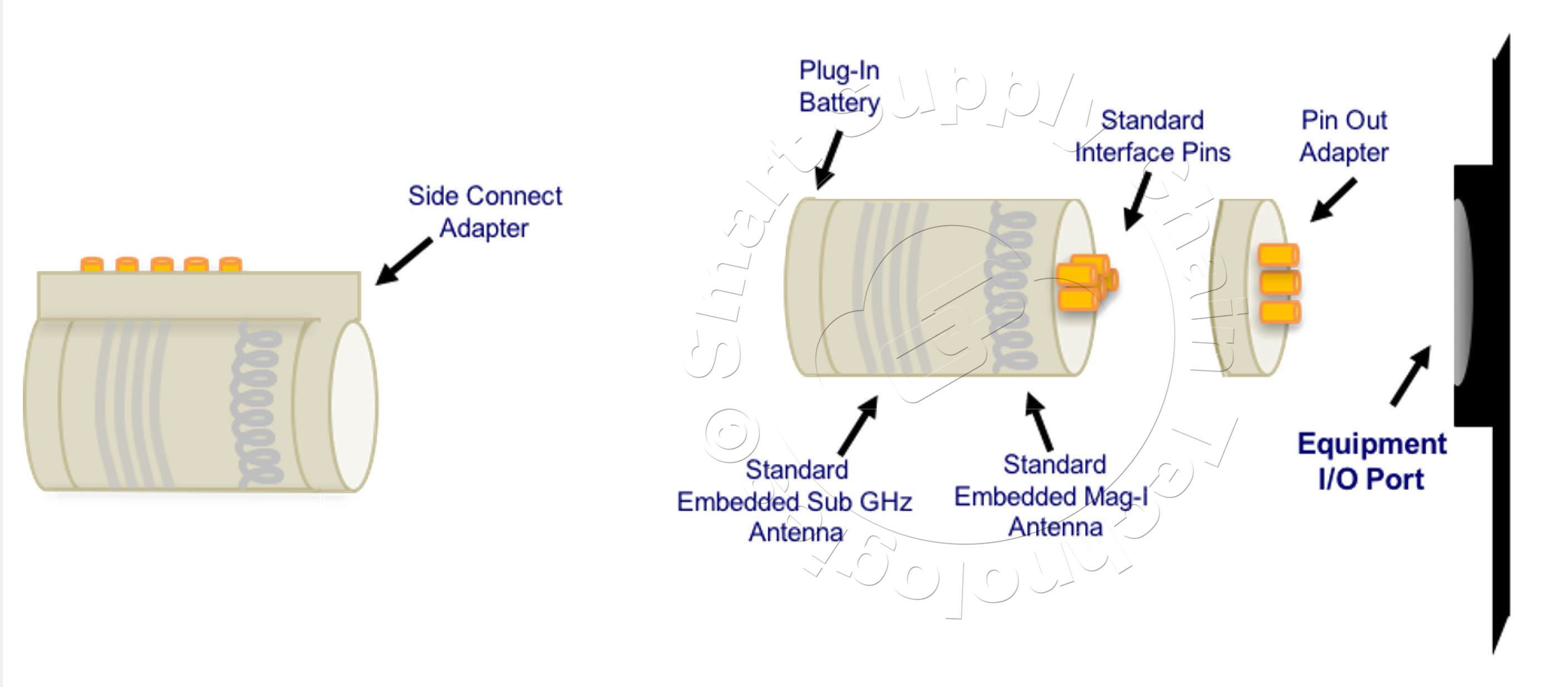 Our Simple Cloud Cable will provide 6 to 8 GPIO (General Purpose Input Output) pins which can be programmed to interface to a wide range of digital interfaces. This is mostly a physical limitation of the number of pins that can be made available in a small form factor. Consider a simple Raspberry Pi(5) based product can actually support up to 40 GPIO pins along with a number of other pin types including USB and UART. S2CT's entry level Simple Cloud Cable concept makes these pins very flexible in terms of the number of pins exposed, their functions and even where they physically are on the Cloud Cable. The Simple Cloud Cable exposes the GPIO pins on either the side or ends of the device and through adapters, their precise number and physical arrangement can be customized. Maybe more importantly, these pins can be reconfigured to desired protocols, on demand, from the cloud. Immediately after a Cloud Cable is associated with a new asset, it communicates with the asset owner's Asset Management System in the cloud. During these initial communications, the asset owner's Asset Management System determines the type of electronics the Cloud Cable will interface to, what software will be necessary to communicate with the specific electronics, and how the Cloud Cable's I/O pins must be configured before they are activated. The Asset Management System either loads its own communications software for the target electronics or connects with an extended cloud service provider for that software and related services. A cold-storage unit's monitoring and management might be turned over to a Certified Climate Control Services Provider, both capable and authorized to manage the specific electronics. The Cloud Cable's I/O pins are configured and activated by the electronics' communications software.
Our Simple Cloud Cable will provide 6 to 8 GPIO (General Purpose Input Output) pins which can be programmed to interface to a wide range of digital interfaces. This is mostly a physical limitation of the number of pins that can be made available in a small form factor. Consider a simple Raspberry Pi(5) based product can actually support up to 40 GPIO pins along with a number of other pin types including USB and UART. S2CT's entry level Simple Cloud Cable concept makes these pins very flexible in terms of the number of pins exposed, their functions and even where they physically are on the Cloud Cable. The Simple Cloud Cable exposes the GPIO pins on either the side or ends of the device and through adapters, their precise number and physical arrangement can be customized. Maybe more importantly, these pins can be reconfigured to desired protocols, on demand, from the cloud. Immediately after a Cloud Cable is associated with a new asset, it communicates with the asset owner's Asset Management System in the cloud. During these initial communications, the asset owner's Asset Management System determines the type of electronics the Cloud Cable will interface to, what software will be necessary to communicate with the specific electronics, and how the Cloud Cable's I/O pins must be configured before they are activated. The Asset Management System either loads its own communications software for the target electronics or connects with an extended cloud service provider for that software and related services. A cold-storage unit's monitoring and management might be turned over to a Certified Climate Control Services Provider, both capable and authorized to manage the specific electronics. The Cloud Cable's I/O pins are configured and activated by the electronics' communications software.
All of this is extremely important for a Cloud Cable that will move from one asset to another, each new asset being associated with the Cloud Cable, connecting to the appropriate communications software, receiving active pin configurations, and being plugged into the asset's electronic interface. Here the Cloud Cable is clearly a conduit between the asset's electronics and the cloud. Think about a few Cloud Cables being used in a shipping terminal's reefer rack to arbitrarily move from one reefer controller to another to retrieve their trip-data, execute Pre-Trip Inspections and set trip parameters for their expected cargoes. Each time the Cloud Cable is associated with a new asset, the process of staging the correct communications software and reconfiguring the Cloud Cable's I/O pins repeats itself.
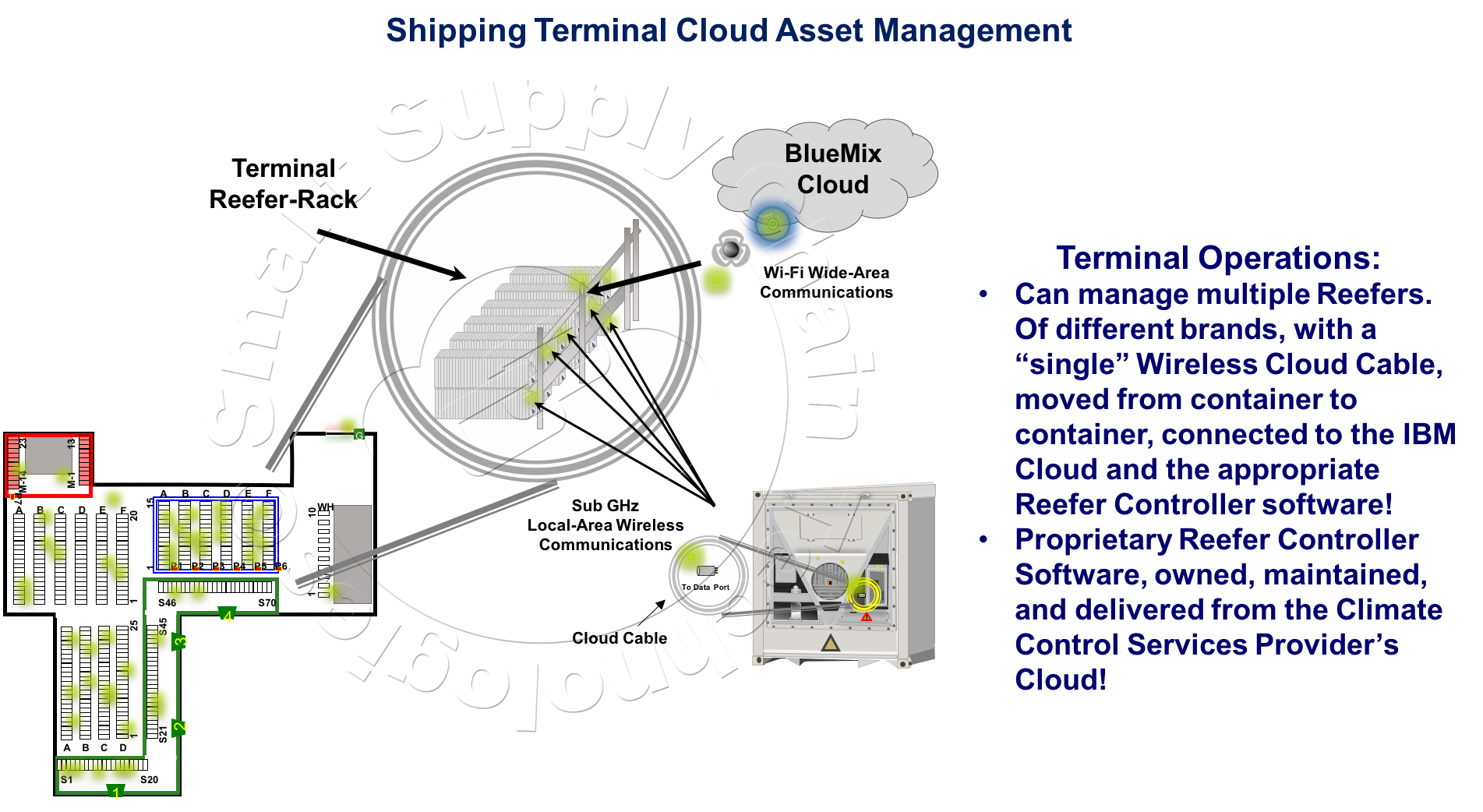
Another Cloud Cable feature that enhances its temporary deployment is a magnetic attachment option. A Cloud Cable can be easily fitted with a magnetic side / end cap magnetic adapter that simply snaps onto the unit's basic enclosure. 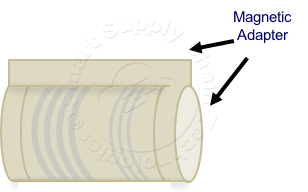 This enables the Cloud Cable to be quickly attached to a metal asset, either along its length or its end, and be moved from one asset to another in seconds. Just touch the Mag-I Tag to associate the Cloud Cable with the new asset, watch for the Association LED to blink, and attach it to the asset's metal superstructure. The cloud and Cloud Cable do the rest!
This enables the Cloud Cable to be quickly attached to a metal asset, either along its length or its end, and be moved from one asset to another in seconds. Just touch the Mag-I Tag to associate the Cloud Cable with the new asset, watch for the Association LED to blink, and attach it to the asset's metal superstructure. The cloud and Cloud Cable do the rest!
Cloud Cable features and functionality can easily be modified at production, with modular hardware elements and their underlying embedded software. S2CT will be releasing a number of Open Source Visual Software Library elements, Node-RED(6) code blocks, for Cloud Cables, with its partners, in the near future. S2CT customers and clients will be able to manage their own pipeline of Cloud Cables from their hardware provider of choice with complete access to this ever-growing Cloud Cable Open Source Library. Anyone will be able to use and deploy these library elements as well as modify them, with the Open Source codes, to suit their specific requirements. Modular hardware and the Visual Embedded Software Library(7) allow a hardware manufacturer and its customer to select a core Cloud Cable design and populate it with add-on functions like Sub GHz communications, GPS, LTE Communications, Ultra-sonic sensors, etc., the list is endless. These add-on components will come with their own driver level embedded firmware software and Application Program Interfaces (APIs) and most will already have available Visual Programming Library Elements. The manufacturer simply manufactures the Cloud Cable with the add-on components plugged into the available Printed Circuit Board I/O (GPIO etc.), connects the library software elements as intended using a simple Programming Pad(8) style Interactive Design Environment, simulate its behavior until satisfied, and load the software into the microcontroller application space. Done!
S2CT intends to release and maintain for its customers and clients a similar Visual Programing Library, for the IBM Cloud(9) platform, for its Asset Management Network software. Anyone will be able to construct their own Asset Management Network in the IBM Cloud environment with or without S2CT's assistance.
Following are two Raspberry Pi Cloud Cable examples. The first example is an entry level Simple Cloud Cable, without any Wide-Area-Network (WAN) capabilities. The second example is a Wi-Fi enabled WAN Cloud Cable, capable of connecting with the Simple Cloud Cable example device and forwarding its data to the cloud.
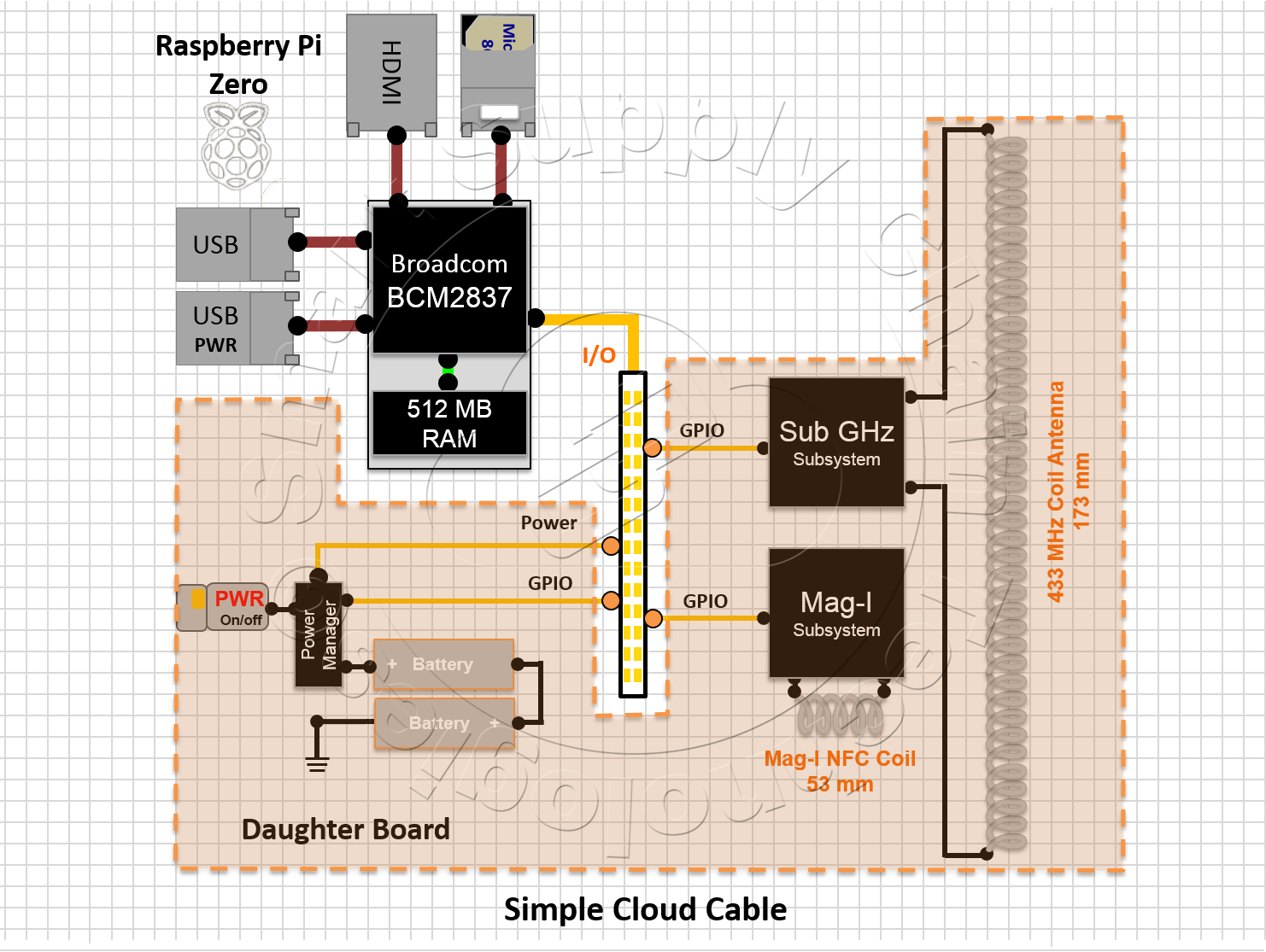
Entry level Simple Cloud Cables can be Raspberry Pi Zero based with a standard Cloud Cable daughter-card that provides Sub GHz Communications, Mag-I Communications and an S2CT Smart Power System with Advanced Machine Learning Power Management(10). The Power System accommodates batteries and can also use externally supplied DC power. This simple, inexpensive, entry level Simple Cloud Cable reaches the cloud by connecting through Sub GHz with another device that connects to the Internet, a Sub GHz enabled Wi-Fi Access Point or a Wi-Fi enabled WAN Cloud Cable, for example.
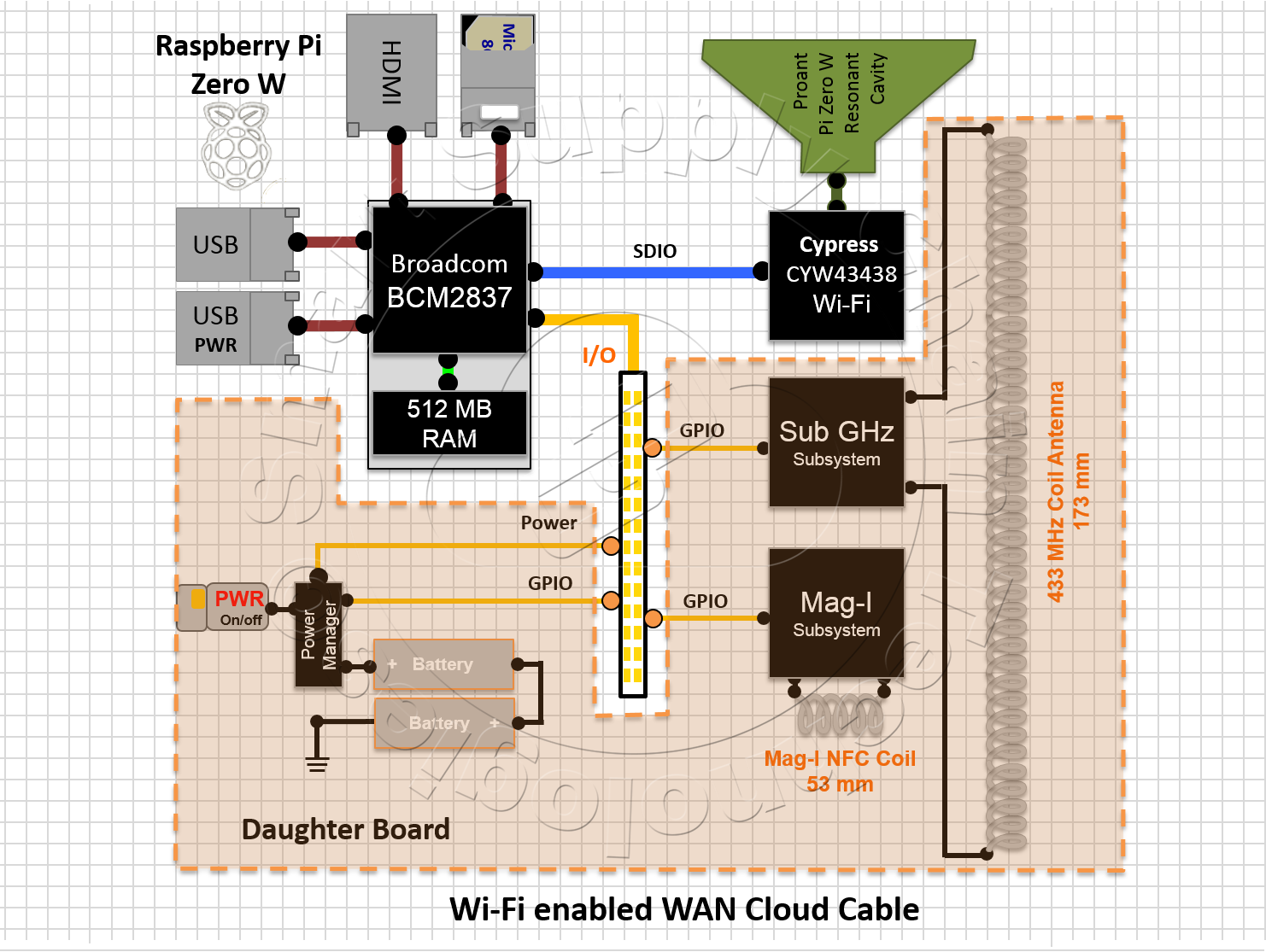
Wi-Fi enabled WAN Cloud Cables can be Raspberry Pi Zero W based with a standard Cloud Cable daughter-card that provides Sub GHz Communications, Mag-I Communications and an S2CT Smart Power System with Advanced Machine Learning Power Management. The Power System accommodates batteries and can also use externally supplied DC power. This still inexpensive Wi-Fi enabled WAN Cloud Cable reaches the cloud directly through its integrated Wi-Fi capability. This is a powerful device capable of operating as either a Wi-Fi Access Point or Wi-Fi node. S2CT is deep into the development of a Wi-Fi Cloud Mesh Architecture(11) where Wi-Fi Access Points, that are far apart and have no overlapping field of coverage, form a Mesh by using the Internet to create a virtual overlap.
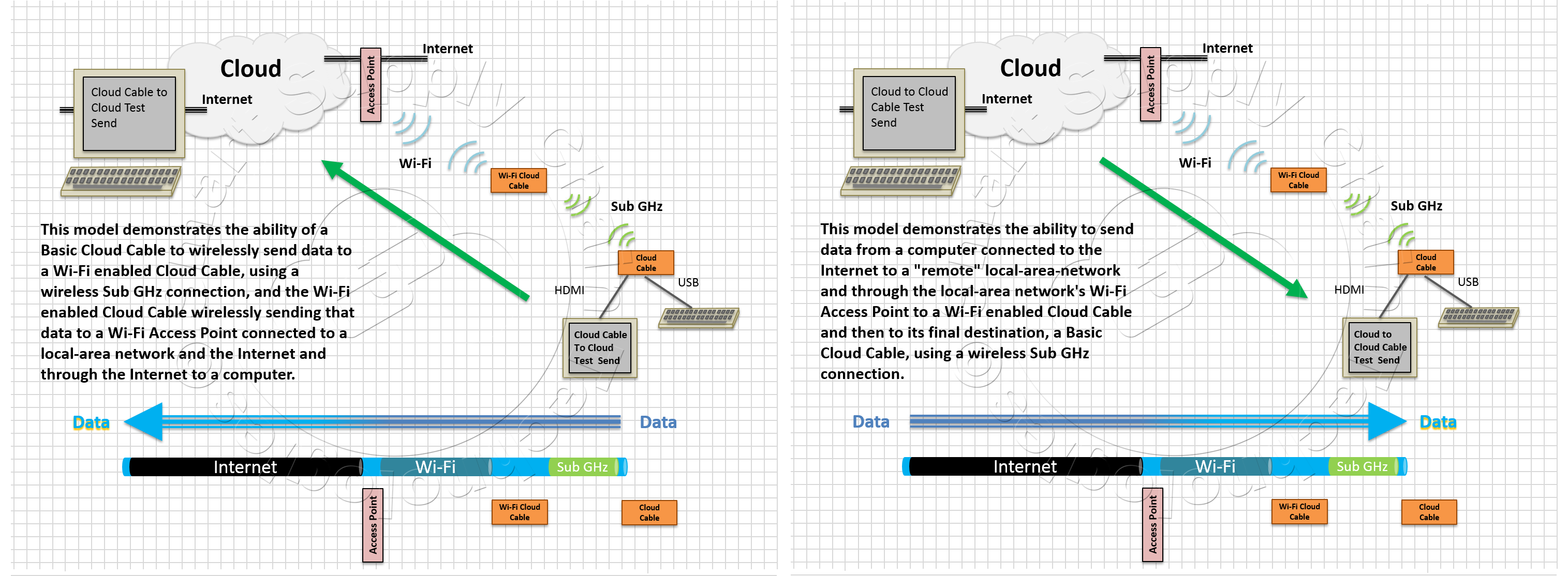
The left pane, illustrates the communications operations of a Simple Cloud Cable communicating its data to a Wi-Fi enabled WAN Cloud Cable, the Wi-Fi enabled WAN Cloud Cable communicating that data to a Wi-Fi Access Point that is hardwire connected to the Internet, and the Internet communicating the data to the cloud and a specific Asset Management System.
The right pane, illustrates the cloud, the Asset Management System, communicating back to the Simple Cloud Cable through the same path but with data moving in the opposite direction. The Simple Cloud Cable might have informed the Asset Management System that the temperature in its cargo area had reached an alert point, too hot or too cold. The Asset Management System responds by sending a command to the asset's refrigeration controller to modify its output temperature to achieve a specific goal temperature. The Simple Cloud Cable delivers that message to the refrigeration controller and it executes the instruction.
The amazing little Cloud Cable!
(1) Sub GHz is a bidirectional communications frequency that is best suited for communications in and around Highly Metalized Environments (HME). The actual frequency selection is driven by the reliability of the communications and the power consumed to undertake them. S2CT has developed an "Open Protocol Standard" called HME Sub GHz, 433 MHz for this purpose. Alternatively, the new Sub GHz 900 MHz Wi-Fi 802.11ah IEEE Standard is another good choice and is currently being analyzed by S2CT and Hong Kong City University.
(2) A proportional–integral–derivative controller (PID controller) is a control loop feedback mechanism widely used in industrial control systems requiring continuously modulated control. 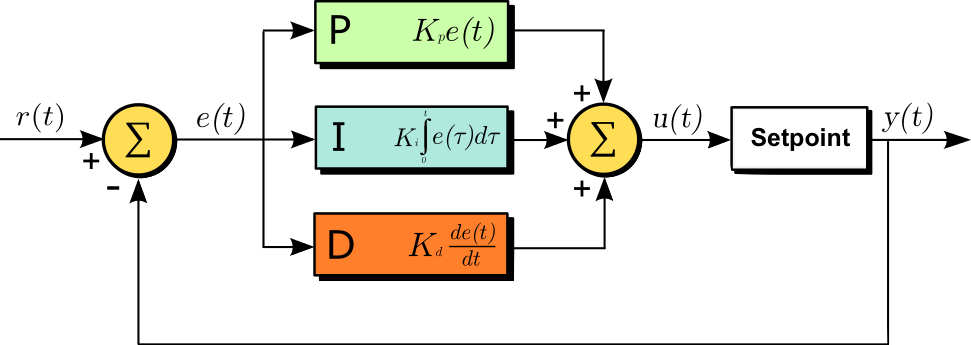 A PID controller continuously calculates an error value as the difference between the desired setpoint and a measured process variable and applies a correction based on proportional, integral, and derivative terms.
A PID controller continuously calculates an error value as the difference between the desired setpoint and a measured process variable and applies a correction based on proportional, integral, and derivative terms.
(3) Near-Field Magnetic Inductance is very similar to the technology that Samsung and others use for secure wireless payment transactions. Fundamentally, two magnetic fields intersect to form a continuity. In this use model, one field emanates from one device and a second field emanates from a second device. When these fields intersect they form a continuity that allows the devices to communicate with one another. Here, one device provides its ID to a second device. The second device, using some methods, verifies that the ID is authorized for communications and associates it in its communications network for future communications.
(4) 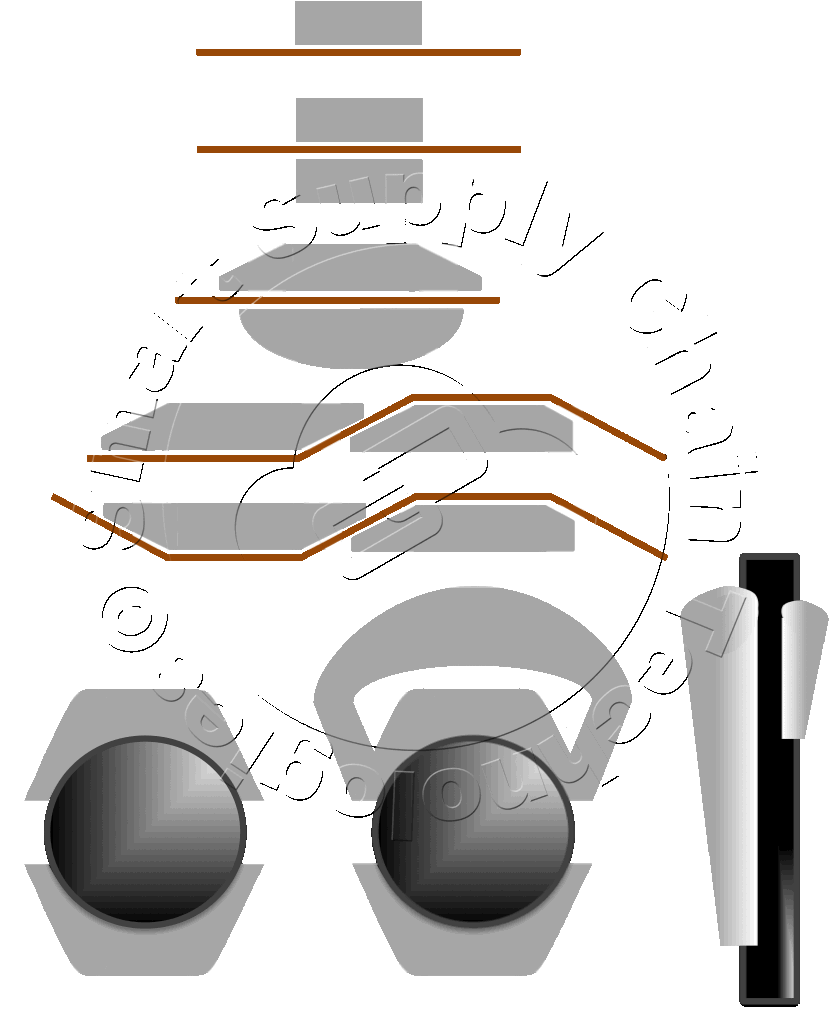 The S2CT Universal Enclosure concept is based on a standard core IP-67 enclosure, safely enclosing the core components of an electronic device, that is designed to be further encased in an exoskeleton of arbitrary exterior shape specifically designed to form fit to a targeted application. A Cloud Cable or other Asset Monitor designed to blend into the superstructure of a cargo container so as not to call attention to its presence is an example.
The S2CT Universal Enclosure concept is based on a standard core IP-67 enclosure, safely enclosing the core components of an electronic device, that is designed to be further encased in an exoskeleton of arbitrary exterior shape specifically designed to form fit to a targeted application. A Cloud Cable or other Asset Monitor designed to blend into the superstructure of a cargo container so as not to call attention to its presence is an example.
(5) Raspberry Pi is the name of a series of small single-board computers developed in the United Kingdom by the Raspberry Pi Foundation.
(6) Node-RED is a powerful tool for building Internet of Things (IoT) applications with a focus on simplifying the 'wiring together' of code blocks to carry out tasks. It uses a visual programming approach that allows developers to connect predefined code blocks, known as 'nodes', together to perform a task. Node-RED was developed as an open source project at IBM in late 2013, to meet their need to quickly connect hardware and devices to web services and other software. Node-RED has rapidly developed a significant and growing user base and an active developer community who are contributing new nodes that allow programmers to reuse Node-RED code for a wide variety of tasks. Node-RED is part of the JS Foundation, of which IBM is a founding member.
(7) A Visual Embedded Software Library is a library of blocks of programming code that perform specific functions that can be connected together to perform a larger task. A Visual Embedded Library contains blocks of code that use the Application Program Interfaces (API) exposed by device level firmware of various electronic modules, microcontrollers, Wi-Fi Communications, GPS Communications, etc. to perform tasks. Get GPS Position is an example of such a block that when called, sends messages through the GPS Module's APIs to the GPS module to search for GPS Satellites, retrieve GPS data from each, consolidate the data and return the GPS position.
(8) Programming Pad is a term used to describe a work area on a computer's display where blocks that represent software functions, get data, encrypt data, store data, etc., are graphically placed and connected together to perform a systematic programming function.
(9)  IBM Cloud is a cloud platform as a service (PaaS) developed by IBM. It supports several programming languages and services as well as integrated DevOps to build, run, deploy and manage applications on the cloud. Bluemix is based on Cloud Foundry open technology and runs on SoftLayer infrastructure.
IBM Cloud is a cloud platform as a service (PaaS) developed by IBM. It supports several programming languages and services as well as integrated DevOps to build, run, deploy and manage applications on the cloud. Bluemix is based on Cloud Foundry open technology and runs on SoftLayer infrastructure.
(10) S2CT Advanced Machine Learning Power Management (AMLPM) is fundamental software that accumulates information operational data from a power subsystem over time and uses it to make judgements about using energy to perform a task. AMLPM might decide to prematurely terminate a GPS cycle based on the time it has taken to find the 1st GPS satellite and when the previous GPS data was acquired.
(11) 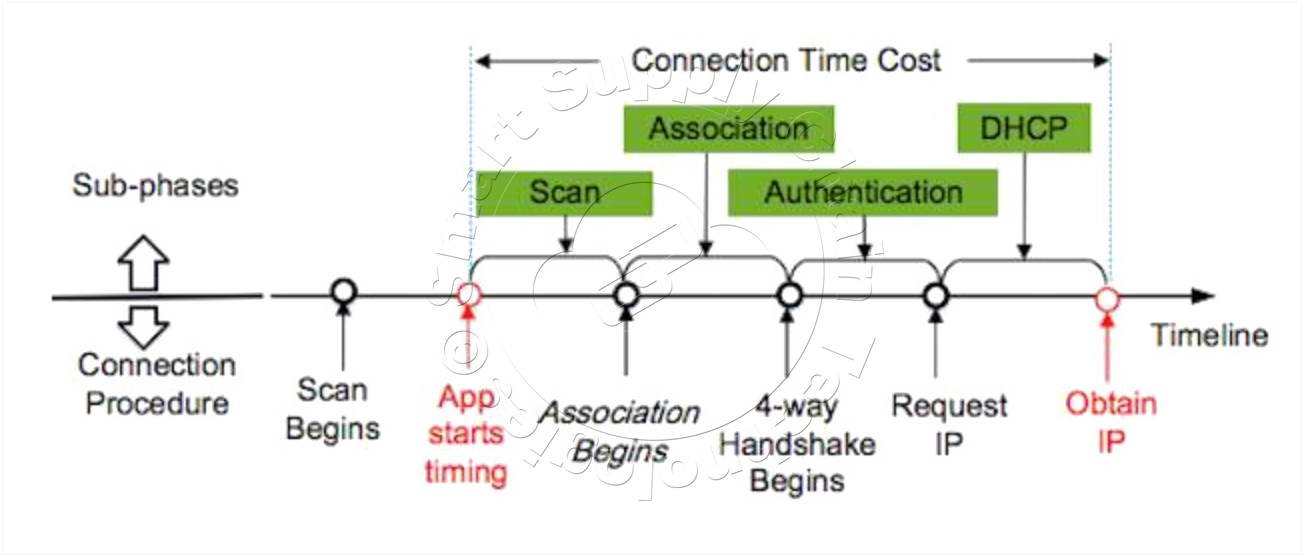 Wi-Fi Cloud Mesh Architecture is the concept that disjoint Wi-Fi Access Points, no actual Wi-Fi field of coverage overlap, can operate as a mesh network by using their common Internet connection to form a virtual overlap. The Wi-Fi node attempting to maintain a persistent connection between these disjoint Wi-Fi Access Points uses the same Wi-Fi Access Point data successfully used in its first successful connection to shorten the Scan, Association, Authentication and DHCP to dramatically reduce the connection overhead for new Cloud Meshed Wi-Fi Access Points it encounters.
Wi-Fi Cloud Mesh Architecture is the concept that disjoint Wi-Fi Access Points, no actual Wi-Fi field of coverage overlap, can operate as a mesh network by using their common Internet connection to form a virtual overlap. The Wi-Fi node attempting to maintain a persistent connection between these disjoint Wi-Fi Access Points uses the same Wi-Fi Access Point data successfully used in its first successful connection to shorten the Scan, Association, Authentication and DHCP to dramatically reduce the connection overhead for new Cloud Meshed Wi-Fi Access Points it encounters.
(*)All company names are trademarks™ or registered® trademarks of their respective holders. Use of them does not imply any affiliation with or endorsement by them.